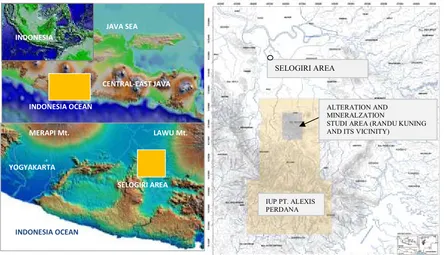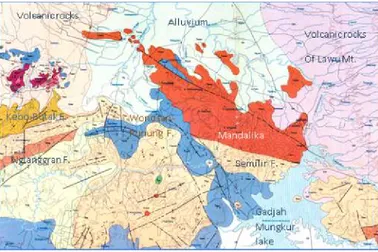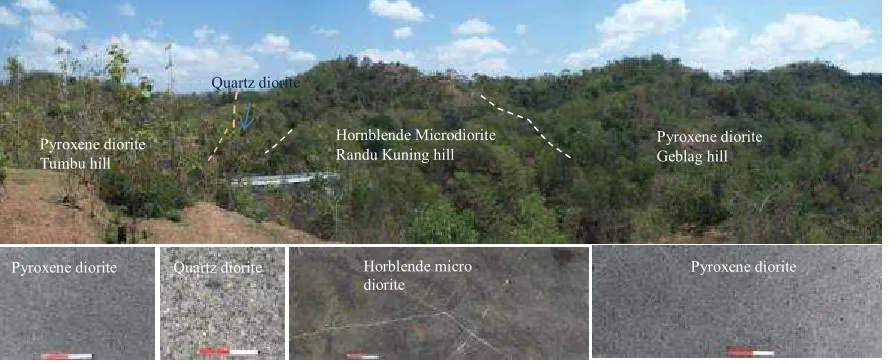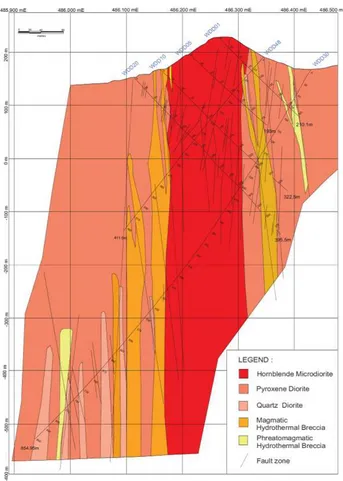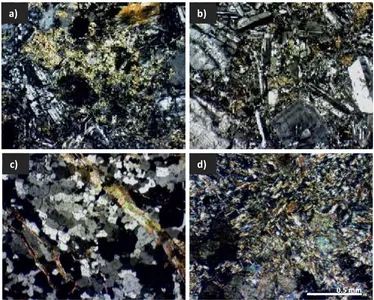316
MAGMATISM AND PORPHYRY Cu-Au MINERALISATION AT THE RANDU
KUNING PROSPECT, SELOGIRI AREA, CENTRAL JAVA
SUTARTO1,2), Arifudin IDRUS2), Sapto PUTRANTO3), Agung HARJOKO2), Lucas Donny SETIJADJI2),
Michael MEYER4) and Rama DANY1)
1)Universitas Pembangunan Nasional “Veteran” Yogyakarta
The Randu Kuning Porphyry Cu-Au prospect area is situated at Selogiri district, Wonogiri regency, Central Java, Indonesia, about 40 km to the south-east from Solo city, or approximately 70 km east of Yogyakarta city.
The Randu Kuning area and its vicinity is a part of the East Java Southern Mountain Zone, mostly occupied by both plutonic and volcanic igneous rocks, volcaniclastic rocks, silisiclastic rocks and also carbonate rocks. Magmatism-volcanism products at Selogiri area were indicated by the abundant of igneous rocks and volcaniclastic rocks of Mandalika and Semilir Formation and many dioritic intrusive rocks as part of the Late Eocene-Early Miocene magmatism. Porphyry Cu-Au mineralisation at Randu Kuning Prospect have strong genetic correlation with the Tertiary magmatism-volcanism processes. Three types of dioritic-andesitic intrusive rocks at the Randu Kuning Prospect, include hornblende-pyroxene diorite, horblende microdiorite, and quartz diorite are distributed at the centre of a half-circular depression on approximately 8 km in diameter is thought to be a feeder of an ancient volcanic crater. Porphyry Cu-Au mineralisation at the area related with the hornblende microdiorite intrusion process.
The alteration type at the Randu Kuning area and its vicinity can be divided into several zones of hydrothermal alteration, such as the potassic zone (magnetite-biotite-K feldspar), prophyllitic zone (chlorite-magnetite-epidote-carbonate), phyllic zone (quartz-sericite-chlorite) and argillic zones (clay mineral-sericite). The alteration pattern in the Randu Kuning porphyry Cu-Au deposit is tipically a diorite model which characterized by the domination of potassic alteration zone on the inside and propylitic type on the outside. Phyllic and argillic alteration type sometimes appear, although with a small volume commontly associated with the presence of fault zones.
At least two mineralization style recognised at the Randu Kuning area i.e.Cu-Au disseminated mineralization, mostly occured associated with the present of chalcopyrite-pyrite dissemination within magnetite-actinolite-epidote±chlorite alteration (inner prophyllitic) and Cu-Au quartz-sulphide vein mineralization, including quartz-chalcopyrite veins, chalcopyrite veins and pyrite-chalcopyrite-sphalerite-carboate veins. Quarzt-sulphide veins mostly associated within the potassic and argillic alteration zone, but a few quartz veins also were found within prophyllitic zone.
Key words: magmatism, hydrothermal, Cu-Au mineralisation
Seminar Nasional Kebumian-VIII
Yogyakaarta, 5 September 2013
Fakultas Teknologi Mineral
317
1. INTRODUCTION
1.1
BackgroundThe Randu Kuning area and its vicinity is a part of the East Java Southern Mountain Zone, mostly occupied by both plutonic and volcanic igneous rocks, volcanic clastic rocks, silisic clastic rocks and also carbonate rocks. Magmatism and vulcanism in this area is represented by Mandalika Formation consisting mostly volcanic igneous rock such as andesit-dacitic lavas, volcaniclastic rocks namely dacitic tuffs, and volcanic breccias. The rock unit was intruded by dioritic intrusive rocks. Volcaniclastic rocks of the Semilir Formation , as a product of the huge eruption, are exposed and scattered at the south of Selogiri area such as tuffs, lapilli tuffs, dacitic pumice breccias, tuffaceous sandstones and tuffaceous shales.
Magmatism and volcanism play important role in developing many hydrothermal type deposit such as porphyry and epithermal mineralization. Magmatism and mineralization in east Java zone is unique and has several different geological characteristics comparing with those of Central Java and West Java zone, which are: a) Found many alkaline and shoshonitic magmatic affinity of back arc volcanos such as Ringgit Beser and Muria volcano, b). Found many acid composition igneous rocks (dacite, ryolite and granitoid rocks), especially in Pacitan and Merubetiri area ( was called as Mrawan Granite), c). Volcanic rocks in East Java geochemically has higher content of Sr and the ratio of Sr / Y (Setiadji et al., 2006), indicate the possibility of adakitic magmatism and d). At least two porphyry (Cu-Au) type were found within this arc segment, i.e. Randu Kuning Porphyry Cu-Au (Wonogiri) and Tumpang Pitu Porphyry Cu-Mo-Au deposit (Banyuwangi), while in West Java and Central are dominated by low sulphidation Epithermal (Au-Ag) type deposit.
Mineralisation type of Randu Kuning prospect was interpreted as porphyry Cu-Au ore deposit and a number gold-base metals epithermal deposits in its surrounding (Imai et al. 2007; Suasta and Sinugroho, 2011; Corbett, 2011, 2012 and Muthi et al., 2012). The intensive erosion process has uncovered the upper parts of the porphyry deposit, whereas several gold-base metal epithermal are preserved along adjacent ridge (Suasta and Sinugroho, 2011). Many epithermal veins also found and crosscut into deeply porphyry veins and related potassic alteration (Suasta and Sinugroho, 2011; Corbett, 2012).
Suasta and Sinugroho (2011), had identified four types of hydrothermal alteration,
i.e. potassic type, prophyllitic type, argillic type and phylic type and reported that the horblende microdiorite was potassic-propylitic altered and mineralize, otherwise the hornblende diorite was propylitic altered only. Retrograde phyllic (silica-sericite-chlorite-pyrite) only locally overprints prograde potassic-prophyllitic zone, mainly adjacent to fault zone and breccias (Corbett, 2012). In over all, the alteration zone are dominated by potassic and prophyllitic type, and lacking with argillic and phyllic type. A dioritic composition range of the intrusive rocks type and the domination of the potassic and prophyllitic zone, based on the porphyry alteration model (Pirajno, 1992; Pirajno, 2009) suggested that the alteration model of the Cu-Au porphyry ore deposit in the study area is more similar to the diorite model rather than the quartz monzonite model.
318 Merapi
of porphyry to epithermal mineralization at several locations in the world have reported (e.g.: Hedenquist et al., 1998; Muntean and Einaudi, 2001; Kouzmanov et.al., 2009), but in Indonesia this theme has never been studied in detail by the intergrating data approach mentioned above.
1.3. Location and Accessibility
The Randu Kuning Porphyry Cu-Au and low sulphidation Au prospect area, situated in Selogiri, Wonogiri, Central Java, Indonesia. This location is reachable with four wheel or two wheel vehicle, about 40 km to the south-east from Solo city, or approximately 70 km east of Yogyakarta city.
1.6. Objectives
the objectives of the research is as follows:
1. Understanding the magmatism processes and tectonic setting of the pre-mineralization and syn-pre-mineralization intrusive rocks.
2. Arrange the mineral paragenetic sequence of the Randu Kuning porphyry Cu-Au to low sulphidation epithermal Au deposits.
1.7. Methodology
This paper is a preliminary study and a part of the dissertation research. The research activities include literature study, proposal writing, field work, laboratory works, data analysis, data interpretation. Desk study including literature study, remote sensing analyses and secondary data collecting is a very important work to support the research activities especially to support fieldwork. Several secondary data are need to support this research, including reports or papers of previous investigations, geological regional maps,
landsat imageries and aerial photos.
The fieldwork means geological mamping and drilling core logging, covers several works iincluding describing all of the rock types, hydrothermal alteration types,
Fig. 1. Location map of the Selogiri area
319 describing all of the vein type and rock sampling for laboratory analyses purposes. Laboratory work still limited petrographic and ore microscopic analyses only, while the other laboratory analyses, are in preparation. Petrographic analyses using thin section preparation will help to identify primary (rock forming minerals) and secondary minerals that formed by hydrothermal alteration as well as their rock textures. This analyses will help to describe the kind of rock type and also the alteration hydrothermal type. Whereas ore microscopic analyses using polished section preparation used to identify opaque minerals (ore minerals), their textures and occurrences.
2. MAGMATISM
Magmatic arc of Java is part of Sunda-Banda arc, extendening from Sumatra trough Java to east of Damar Island which has a length about 3.700 km, known has many potential ore deposits (van Leeuwen, 1994; Charlile and Mitchell, 1994). The arc is the longest arc in Indonesia, developed by northwards subduction of the Indian-Australian Oceanic Plate beneath the southeastern margin of Eurasian continental plate, named the Sundaland (Hamilton, 1979; Katili, 1989). The Tertiary magmatism on Java could be divided into two periods, i.e. the Late Eocene – Early Miocene magmatism and the Late Miocene-Pliocene magmatism (Soeria-atmadja et al. 1991). The volcanic rocks of Late Eocene – Early Miocene magmatism are widespread at alongside southern part of Java, which usually has tholeitic affinity, while the Late Miocene-Pliocene magmatism has Calc Alkaline-High K Calc Alkaline series, distributed mostly on the northward from the Late Eocene – Early Miocene magmatism (Soeria-atmadja, et al. , 1991). The eldest igneous rock of the Tertiary magmatic arch of Java is found at Pacitan area, East Java has showed age of about 42,73 ±9,87 m.a. This sample was taken from tholeitic lava andesite of Besole Formation (Soeria-atmadja et al, 1994; Sutanto et al, 1994).
Magmatism-volcanism products at Selogiri area indicated by the abundant of igneous rocks and volcanic clastic rocks of Mandalika and Semilir Formation as part of the Late Eocene-Early Miocene magmatism. A K/Ar age of the diorite porphyry within Mandalika Formation in the south flank of a wall of the drepression is 21.7 Ma (JICA-JOGMEG, 2004 in Imai et al. 2007). The eruption and deposition of the Semilir Formation is believed as the final stage of volcanic activity in the the Southern Mountains Arcs, which distributed as over a wide area and may be comparible to the Pleistocene eruption of Toba in Sumatra (Smyth et al., 2008). After the Semilir eruption, there was a lull in volcanic activity during the Midle Miocene (Smyth et al., 2008), followed by the movement in Late Miocene-Pliocene arch activity to the north of the Late Eocene-Early Miocene of the Southern Mountain Arc.
320 Many dioritic composition intrusive rock were found at the research area, include pre-mineralisation intrusive rocks, syn-mineralisation intrusive rocks as well as post-mineralisation intrusive rock. In reality, it’s difficult to distinguish of the dioritic rocks type in the area due to their similar composition. Corbett (2012) suggested that the intrusions in the area may be distinguished in many ways such by differences in alteration style (e.g. K feldspar–secondary biotite or silica-sericite-pyrite overprint), quartz vein populations and presence or absence of disseminated mineralisation. Beside those above criterias, the intrusion type also can distinguish by crystal size differences, colour index as well as the porphyrytic texture’s phenocryst density. Based on the observation both on the surface outcrops and drilling core samples, the intrusive rocks at the study area consists of:
a. pre-mineralisation intrusive rocks, including feldspar diorite (as a xenolith within pyroxene diorite) and pyroxene diorite (previous researcher called as medium diorite).
b. syn-mineralisation intrusive rocks, i.e. hornblende microdiorite (previous researcher called as microdiorite) and quartz diorite (previous researcher called as coarse diorite)
321
Quartz diorite Horblende micro Pyroxene diorite
diorite Pyroxene diorite
Imai et al. (2007) have identified three different type of intrusive rocks, namely hornblende andesite porphyry, hornblende diorite porphyry and hornblende diorite. Muthi et al.,(2012) recognized there are at least four type diorite at the Randu Kuning area ie. coarse grain diorite, medium diorite, microdiorite and porphyrytic plagioclase diorite. Dioritic intrusive rocks from Selogiri area are characterized generally by wide variation of SiO2 contents (50.93-66.06 wt.%), high amounts of Al2O3 (mostly 14-18 wt.%), low TiO2 contents (<1 wt.%) and low Na2O and MgO contain (Warmada et al.,2007; Imai, et al., 2007). The dioritic intrusive rocks in Selogiri are genetically associated with the present uncommon porphyry Cu-Au deposit in Java give a number questions on many geology experts. Setijadji et al., (2006) reported the possibility the occurence of adakitic rocks in term of the Sr/Y vs Y diagram in Central-East Java, Sunda-Banda arc, including the Selogiri area. Imai et al., (2007) in contrast reported that the dioritic intrusive rocks in selogiri area show the characteristic of common arc rock that are tipical of Miocene igneous rocks in Central-East Java, and the development of porphyry Cu-Au deposit may due to the intermediete to silisic hydrous magmatism.
Fig. 3. Pyroxen diorite of the Tumbu and Geblag hill intruded by Microdiorite of the Randu Kuning hill. Both pyroxene diorite and hornblende microdiorite cut by quartz diorite intrusive. Photo was taken from Lancip hill (top) and some drilling core samples: pyroxene diorite right (WDD 02-128.50), pyroxene diorite right (WDD 29-80.55), hornblende microdiorite (WDD 45-31.20) annd quartz diorite (WDD 18-161.70).
Hornblende Microdiorite Randu Kuning hill
Pyroxene diorite Geblag hill Pyroxene diorite
Tumbu hill
322
3. ALTERATION HYDROTHERMAL AND MINERALIZATION
Most of hydrothermal deposit types recognized in Java arc are epithermal systems. Although the indication of the other mineralization type, such as porphyry type, skarn type and masive sulfide type are also found in several places. Epithermal mineralizations in West Java lie within and on flanks of Bayah Dome. Two noticeably different style of adularia-sericite epithermal gold deposits are found in the Bayah Dome, they are referred as Pongkor and Cirotan types (Marcoux and Milesi, 1994).Mineralization in Cibunasih, South Tasikmalaya showing gypsum and barite in green tuff, indicating the possibility of the massive volcanogenic type (Setiawan and Yudawinata, 2000). Indications of mineralization type Cu-Au Porphyry and skarn, are also found in several places, such as in Tumpang Pitu Banyuwangi, Pacitan, Lumajang, and Selogiri (Prihatmoko, et al.2002, Muthi, et al., 2012,).
Many experts have been reported about a magmatic related hydrothermal alteration at the Selogiri area. According to Suasta and Sinugroho (2011), had identified three type of hydrothermal alteration, i.e. potassic type, argillic type and prophyllitic type and
323 reported that the horblende microdiorite was potassic-propylitic altered and mineralize, otherwise the hornblende diorite was propylitic altered only. Alteration zones distribution are generally more controlled by the direction of the NE-SW trending structure rather than NW-SE.
Quarzt-sulphide veins mostly associated within the potassic and argillic alteration zone, but a few quartz veins also were found within prophyllitic zone.
The Porphyry Cu-Au mineralisation occure in the Jendi village or Randu Kuning Prospect. There are many indications that reinforce this argument, such as quartz-sulphide-oxide vein stockwork, disseminated chalcopyrite and bornit, as well as the present of malachite in the weathered zones. Most veins are B type and usually narrow (<1 cm) consisting of continuous, planar structurs with paralle walls and usually with center line filled by iron and copper oxides after sulphide, vein selvages are commonly K-feldspar and sericite ( Suasta and Sinogroho (2011). Iron oxide minerals and malachite are common exposed in the weathered rocks, especially in the surrounding quartz-sulphide veins. Epithermal Au-Zn-Pb mineralisation also found in the surrounding of the Randu Kuning Porphyry Cu-Au deposit, associated with crustiform-colloform quartz-carbonate veins, hosted within volcanic clatic rocks.
At least four types of hydrothermal alteration at the Randu Kuning area and its vicinity had identified, i.e. potassic type, prophyllitic type, argillic type and phyllic type. Potassic alteration zone scattered on microdiorite intrusive rocks body and small part of pyroxene diorite intrusive rocks especially in contact to the microdiorite intrusion of Randu Kuning hill. This zone characterized by secondary minerals assemblage i.e. one or both of secondary biotite and/or K-feldspar associated with magnetite (Suasta and Sinugroho, 2011; Corbett, 2011, 2012 and Muthi et al., 2012). Prophyllitic alteration is less commontly recognised typically as actinolite or chlorite-epidote-magnetite alteration at the margin of the hydrothermal system (Corbett, 2012). Prophyllitic zone mostly is widespread in pyroxene diorite and quartz diorite rocks, both visible at the surface outcrop and in drill core samples.
quartz-324 Phyllic alteration is commontly appear in the fault structure zones, locally overprint to the potassic alteration and prophyllitic zone, on pyroxene diorite rocks, microdiorite hornblende as well as quartz diorite (Suasta and Sinugroho, 2011; Corbett, 2011, 2012 and Muthi et al., 2012). This zone characterized by retrograde silica-sericite-chlorite pyrite is mostly limited to fault zones or selvages to late stage quartz-pyrite veins likened to D veins (Corbett, 2012). Argillic zone appear mainly adjacent to breccia and fault zone, especially in the epithermal prospect area, characterized by the present of the clay minerals. Illite and monmorillonite are the main minerals identified in the vein samples suggesting structural controlled argillic alteration (Muthi et al., 2012).
Corbett (2011; 2012) suggesting many mineralization style recognised at the Randu Kuning area, and can be summarized as follows:
a) Cu-Au disseminated mineralization. This mineralisation style mostly occured associated with the present of chalcopyrite-pyrite dissemination within magnetite-actinolite-epidote±chlorite alteration (inner prophyllitic) which overprint on potassic alteration. It were found as disseminations, clots, breccia matrix, fracture fill and locally sheeted fracture veins.
Fig. 6. Photomicroscopic (cross plane) of many altered rock type at the research area. a). WDD-09-157.65. Potassic (biotite-alkaline feldspar) type overprinted inner prophyllitic (tremolite-anhydrite-silica). b). WDD-27-426.00. Prophyllitic (silica,chlorite, sericite) altered diorite. c). WDD-49-249.20. Silisic ( silica, carbonate, sericite, chlorite) type cut by carbonate-sericite veinlets. d). WDD-48-27.45 Pyrophyllite-chlorite-clay mineral-silica assemblage.
a) b)
d) c)
325 b) Cu-Au quartz vein mineralization. Some barren quartz veins are recognised in the deeper portion of some intrusions, and mostly associated with the present of magnetite but without sulphides. While in the upper portion and later stage or at the time of the ore fluids ascending, the quartz veins accompanied by minor sulphides and can develope AB veins (formed by the filling at central termination within A veins by sulphides), C veins (chalcopyrite-pyrite veins), and on the reactivated lamination parting of laminated M veins.
c) D veins mineralization. This vein type comprise quartz, sulphides and carbonate with prominent silica-sericite±pyrite alteration salvages. D veins most common occured within fault zones, overprinting of earlier quartz veins and disseminated mineralization. It may contain locally elevated Au to 5 g/t Au, 1.1 g/t Ag and 292 g/t Cu (in DDH WDD 18, 358, 4m with tipically low Ag:Au ratios of 0.2. In the southern dirll hole examined,still showing this style but generally have < 1gr/t Au.
Fig. 7. Many vein mineralization style recognised at the Randu Kuning area: a). quartz-feldspar vein infilled by pyrite vein in centre line, b). pyrite ± chalcopyrite-magnetite vein and c). pyrite-quartz-chalcopyrite+carbonate vein (D vein). d). Photomicroscopic exolution texture of chalcopyrite-sphalerite (chalcopyrite blebs within sphalerite house), indicating deposited in high temperature e). Photomicroscopic of magnetites are replaced by pyrites.
a) WDD 30-365.45
5
d) e)
326 Some D veins (quartz-sulphide veins) formed at deeper levels close and within intrusion source contain chalcopyrite and bornite but another D veins in same elevation contain yellow and sphalerite and contain no chalcopyrite and bornit, indicate a low temperature. Corbett (2012) gave explanation that lower temperatur late stage accured at a higher crustal level after substantial uplift and erosion, or as result of renewed deeper magmatism.
4. CONCLUSION
Two type dioritic intrusive rock controlling two hydrothermal type deposit. The earlier hornblende microdiorite responsible to the porphyry Cu-Au deposit occurence, while the second one or the later quartz diorite was related to the one of many epithermal Au-base metals low sulphidation.
At least three mineralization style have recognised at the Randu Kuning area, i.e. Cu-Au disseminated mineralization style, Cu-Cu-Au quartz vein mineralization and D veins mineralization that contribute in copper-gold enrichment at the area.
5. ACKNOWLEDGMENTS
This paper is part of the preliminary report of the dissertation research field work and some microscopic analyses.On this occasion I would like to thank to management Augur Resources, which has given me permission to do this research in the Selogiri prospect and its vicinity.
5. REFERENCES
Bemmellen, van, R.W, 1949, The Geology of Indonesia, Vol. IA, Gov. Print. Office, The Hague Martinus Nijhoff.
Carlile, J.C. dan Mitchell, A.H.G., 1994, Magmatic Arcs and Associated Gold and Copper Mineralisation in Indonesia, Journal of Geochemical Exploration, Elsevier Science, Amsterdam, 50: 92-142.
Corbett, G., and Leach, T.M.,1996, Southwest Pacific Rim Gold Copper Systems: Structure, Alteration, and Mineralization, Workshop Manual for Presented at Jakarta, August 1996, 186 p.
Corbett, G., 2008, Influence of Magmatic Arc Geothermal Systems on Porphyry-Epithermal Au-Cu-Ag Exploration Models, Paper presented at the Terry Leach Symposium, Sydney, 17 October 2008. Australian Institute of Geoscientist Bulletin 48.
Corbett, G., 2011, Comments on The Exploration Potential of The Wonogiri Porphyry Cu-Au Project, Central Java, Indonesia, Corbett Geological Services Pty. Ltd., p 27.
Corbett, G., 2012, Further Comments on The Wonogiri Porphyry Cu-Au Project Central Java, Indonesia, Corbett Geological Services Pty. Ltd., p 37.
Cooke, D.R., Hollings, P., and Walshe, J.L., 2005, Giant Porphyry Deposits: Characteristics, Distribution, and Tectonic Controls, Economic Geology, v 100, no.5, pp. 801-818.
327 Defant, M.J., dan Drummond, M.S., 1993, Mount St. Helens: Potential Example of The Partial Melting of The Subducted Lithospher in a Volcanic Arc, Geology, v.21, p.547-550.
Gill, J., 1981, Orogenic Andesite and Plate Tectonic, Springer-Verlag, Berlin, 390pp.
Gustafson, L.B. dan Hunt, J.P. 1975, The Porphyry Copper Deposit at El Salvador, Chile,
Economic Geology, v 70:pp. 857-912.
Guilbert,G.M. dan Lowell, J.D., 1974, Variations in Zoning Patterns In Porphyry Ore Deposits, Canadian Inst. Mining and Metallurgy Bull. 67:99-109 (1974)
Guilbert, G.M. dan Park, C.F., JR., 1986, The Geology of Ore Deposits, W.H. Freeman and Company, New York, 985 p.
Hall, R., 2009, Cenozoic Tectonic of SE Asia, Problems and Models of Sumatra and Java,
Unpublised Slide, 1-49.
Hamilton,W.B.1979, Tectonics of the Indonesian Region, Professional Paper 1078,U.S. Geolology Survey, Washington, DC.,345 p.
Hartono, G., 2010, The Role of Paleovolcanism in The Tertiary Volcanic Rock Product Setting at Gajahmungkur Mt., Wonogiri, Central Java, Dissertation, Unpublished, 190 p.
Hedenquist, J.W.,Arribas, A.J., and Reynolds, T.J., 1998, Evolution of Intrusion-Centered Hydrothermal System: Far Southeast-Lepanto Porphyry and Epithermal Cu-Au deposits, Philipines, Economic Geology, v.93, p374-404.
Hellman,P.L., 2010, Tujuh Bukit Project Report on Mineral Resources, Located in East Java, Indonesia, Technical Report for Interprid Mines Limited, http://media.wotnews.com.au/esxann/01120850.pdf.
Idrus, A., 2008, Transport and Deposition of Copper and Gold in Porphyry Deposit: A Contraint From Microthermometry and Hidrothermal Biotite Chemistry, Media Teknik No.3 Tahun XXX Edisi Agustus 2008 ISSN 0216-3012 p.276-283.
Imai, A., Shinomiya, J., Soe, M.T., Setijadji, L.D., Watanabe, K., and Warmada, I.W., 2007, Porphyry-Type Mineralization at Selogiri Area, Wonogiri Regency, Central Java, Indonesia, Resources Geology, vol.57, no. 2:230-240.
Isnawan, D., Sukandarrumidi and Sudarno, I., 2002, Kontrol Struktur Geologi Terhadap Jebakan Tembaga Sebagai Arahan Eksploitasi di Daerah Ngerjo dan Sekitarnya Kecamatan Tirtomoyo, Kabupaten Wonogiri Propinsi Jawa Tengah, Gama Sains IV
(2) Juli 2002, p.149-157.
Katili, J. A., 1989, Evolution of the Southeast Asian arc complex, Geol. Indon. Jakarta, 12: 113-143
328 Leeuwen, van, T.M., 1994, 25 Years of Mineral Exploration and Discovery in Indonesia,
Jornal of Geochemical Exploration, Elsevier Science, Amsterdam, 50: 13-89
Marcoux E. and Milesi, J.P., 1994, Epithermal Gold Deposits in West Java, Indonesia: Geology, Age and Crustal Source, Journal of Geochemical Exploration, Elsevier Science, Amsterdam, 50: 393-408.
Maryono, A.,2008, Porphyry Veining Types and Characteristics, Porphyry Deposit Workshop, Batu Hijau, December 1-5-2008.
Maryono, A., Setijadji, L.D., Arif, J., Harrison, R., Soeriaatmadja, E., 2012, Gold, Silver and Copper Metallogeny of the Eastern Sunda Magmatic Arc Indonesia, Proceding of Banda and Eastern Sunda Arcs 2012 MGEI Annual Convention, 26-27 November 2012, Malang, East Java, Indonesia, p.23-38.
Muntean, J.L. and Einaudi, M.T., 2001, Porphyry-Epithermal Transition: Maricunga Belt, Northern Chile, Economic Geology, Vol. 96, 2001, pp. 743-772.
Muthi, A., Basten, I.G., Suasta, I.G.M., and Litaay, N.E.W., 2012, Characteristic of Alteration and Mineralization at Randu Kuning-Wonogiri Project, Proceding of Banda and Eastern Sunda Arcs 2012 MGEI Annual Convention, 26-27 November 2012, Malang, East Java, Indonesia, p. 117-132.
Nahrowi, T.Y., Suratman, Namida, S. and Hidayat, S., 1979, Geologi Pegunungan Selatan Jawa Timur, Bagian Eksplorasi Pusat Pengembangan Teknologi Minyak dan Gas Bumi, Cepu, 31 p.
Pirajno, F., 2009, Hydrothermal Processes and Mineral Systems, Springer-Geological Survey of Western Australia, 1250 p.
Prihatmoko, S., Digsowilogo, S., and Kusumanto, D., 2002, Potensi Cebakan Mineral di Propinsi Jawa Tengah dan Daerah Istimewa Yogyakarta, in Sumberdaya Geologi Daerah Istimewa Yogyakarta dan Jawa Tengah, Ikatan Ahli Geologi Indonesia Pengurus Daerah DIY-Jateng, p.87-103.
Samudera, H., 1990, Tatanan Stratigrafi dan Tektonik Pegunungan Selatan Jawa Timur, antara Pacitan dan Ponorogo, Bidang Pemetaan Geologi, Pusat Penelitian dan Pengembangan Geologi, 39 p.
Sartono, S., 1964, Stratigraphy and Sedimentation of the Eastern Most Part of Gunung Sewu (East Java), Publikasi Teknik-Seri Geologi Umum No. 1 Direktorat Geologi Bandung, 95 p.
Setijadji, L.D., Kajino, S., Imai, A., and Watanabe, K. ,2006, Cenozoic Island Arc Magmatism in Java Island (Sunda Arc, Indonesia): Clues on Relationships between Geodinamics of Volcanic Centers and Ore Mineralisation, Resources Geology, vol.56,no.3,267-292.
329 Setiawan,B. dan Yudawinata,K., 2000, Review of Mineral Exploration Along the
Sunda-Banda Magmatic Arc, Freeport-ITB Geological Symposium, 13 p.
Sillitoe, R.H., 1994, Indonesian Mineral Deposits Introductory Comments, Comparisons and Speculations, Journal of Geochemical Exploration, vol. 50., p. 1-11.
Sillitoe, R.H., 2010, Porphyry Copper System, Economic Geology v.105, pp.3-41, 2010.
Smyth, H.L., Hall, R. And Nichols, G., 2008, Cenozoic Volcanic Arch History of East Java Indonesia: The Stratigrapahic Record of Eruption on An Active Continental Margin, The Geological Society of America Special Paper 436, p. 199-221.
Soeria-Atmadja, R., Maury,R.C., Bellon,H., Pringgoprawiro,H., Polvé,M., and Priadi,B., 1991, The Teriary Magmatic Belt in Java, The Proceeding of the Silver Jubbiles Symposium On the Dynamics of Subduction and Its Products,Yogyakarta: p. 98-121.
Soeria-Atmadja, R., Maury,R.C., Bellon,H., Pringgoprawiro,H., Polvé,M., and Priadi,B., 1993, Tertiary Magmatic Belt in Java, Journal of Southeast Asian Earth Science, 9, 13-27.
Suasta, I.G.M and Sinugroho, I.A., 2011, Occurence of Zoned Epithermal to Porphyry Type Cu-Au Mineralization at Wonogiri, Central Java, Proceeding of The 36th HAGI and 40th IAGI Annual Convention.
Suprapto, 1998, Model Endapan Emas Epitermal Daerah Nglenggong, Kecamatan selogiri, Kabupaten Wonogiri, Jawa Tengah. Tesis Magister, Program Studi Rekayasa Pertambangan, Fakultas Pasca Sarjana, Institut Teknologi Bandung, 47 p.
Surono, Toha, B., and Sudarno, I., 1992, Geological map of the Surakarta-Giritontro Quadrangles, Java, Geological Research and Development Centre, Bandung.
Surono and Adhiani, M.P., 2009, Semilir Formation, Southern Mountain: as A Result of Huge-Miocene Explosion, Prosiding Workshop Geologi Pegunungan Selatan 2007, Badan Geologi Pusat Survey Geologi, Publikasi Khusus No.38-2009.
Sutanto, Soeria-Atmadja, R., Maury,R.C., and Bellon,H., 1994, Geochronology of Tertiary Volcanism in Java, Prosiding Seminar Geologi dan Geotektonik Pulau Jawa Sejak Akhir Mesosoik Hingga Kuarter, Jurusan Teknik Geologi, Universitas Gajahmada, Yogyakarta, p.53-56.
Sutarto, Sutanto, and Said,S., 2002, Mineralisasi Logam Pada Busur Magmatik Jawa,
Buletin Wimaya, UPN Pres Yogyakarta.
Warmada, I.W., Soe, M.T., Sinomiya, J., Setijadi, L.D., Imai, A., annd Watanabe, K., 2007, Petrology and Geochemistry of Intrusive Rocks From Selogiri Area, Central Java, Indonesia, http://warmada.staff.ugm.ac.id/Articles/petrology-geochem-slgr.pdf. 8 p.
